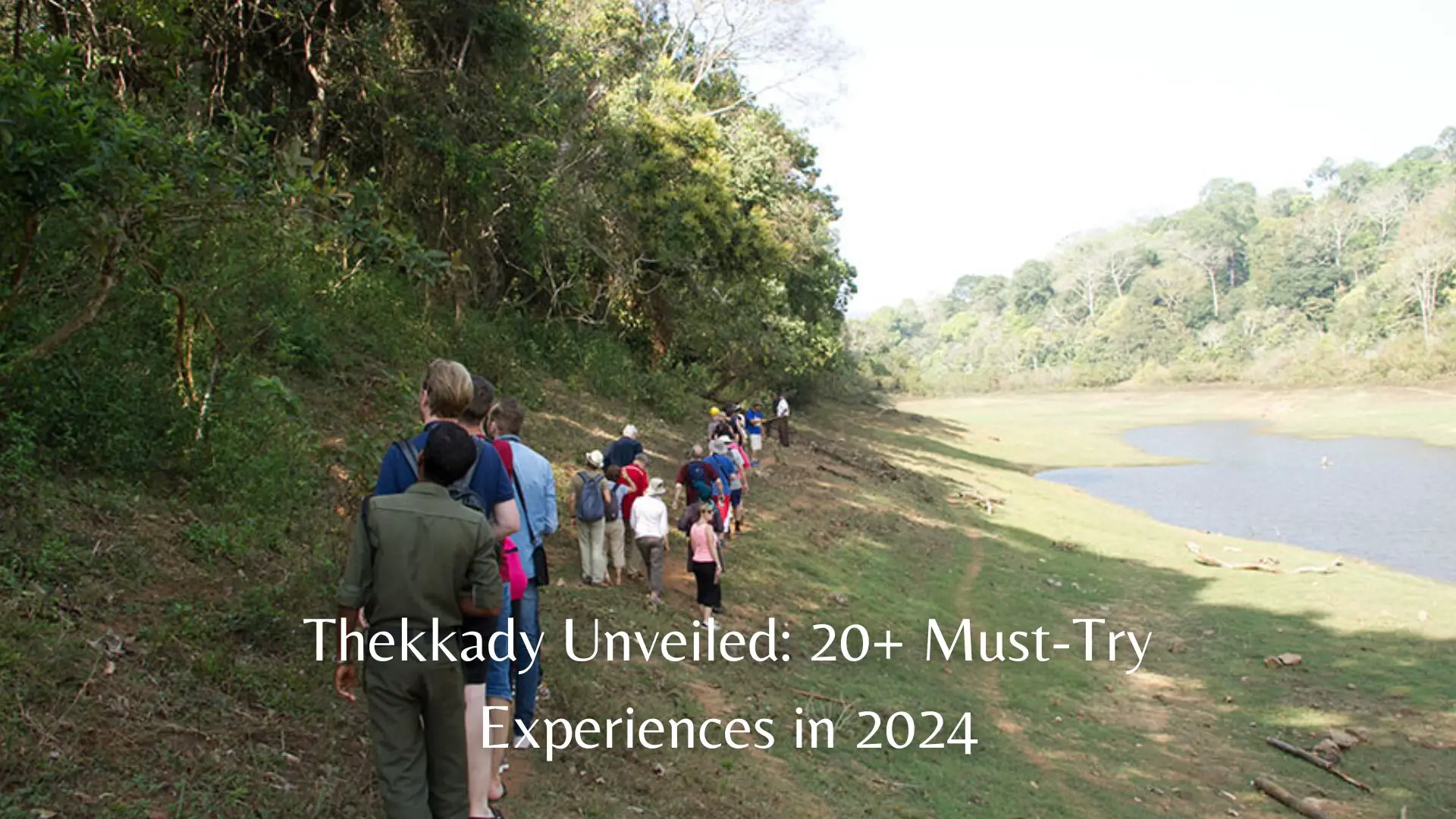Kochi, a picturesque city in Kerala, India, is a melting pot of rich cultural heritage, stunning landscapes, and a vibrant blend of modernity and tradition. As we step into 2024, Kochi continues to be a sought-after destination for travelers seeking a unique and immersive experience. Here’s a curated list of 20+ best places to visit in Kochi this year, promising a delightful journey through its enchanting offerings.
Fort Kochi Beach:
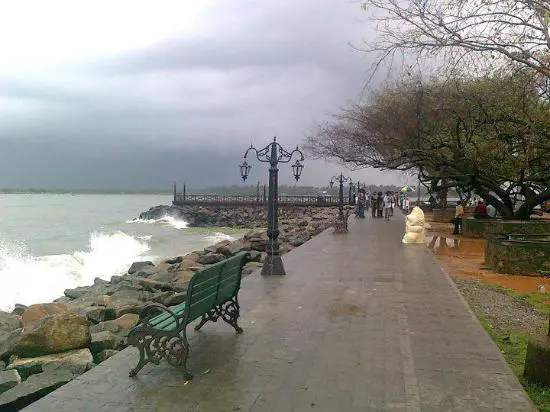
Kickstart your Kochi exploration with the serene Fort Kochi Beach. The Chinese fishing nets, the Vasco da Gama square, and the stunning sunset views make it an ideal spot for a tranquil evening.
Nestled along the serene coastline of Kerala, Fort Kochi Beach stands as a timeless haven where history meets tranquility. Steeped in colonial charm and surrounded by iconic landmarks, this picturesque beach is a must-visit destination for those seeking a perfect blend of relaxation and cultural exploration.
Chinese Fishing Nets:
As you approach Fort Kochi Beach, the iconic Chinese fishing nets instantly capture your attention. These massive, teakwood structures are a symbol of Kochi’s maritime heritage and provide a captivating backdrop against the azure sky.
Historical Significance:
Fort Kochi Beach bears witness to the historical tapestry of the region. The remnants of Fort Immanuel, built by the Portuguese in the early 16th century, stand as silent sentinels, narrating tales of colonial struggles and conquests.
Vasco da Gama Square:
At the heart of Fort Kochi Beach lies Vasco da Gama Square, named after the legendary Portuguese explorer. The square is a vibrant hub with shops, cafes, and a lively atmosphere, making it an ideal spot for leisurely strolls and people-watching.
Artistic Expressions:
Fort Kochi Beach has become a canvas for artistic expression during the Kochi-Muziris Biennale. Sculptures and installations dot the shoreline, creating a dynamic interplay between contemporary art and the natural beauty of the beach.
Sunset Delight:
One of the most enchanting experiences at Fort Kochi Beach is witnessing the sunset. As the sun dips below the horizon, the sky transforms into a mesmerizing palette of hues, casting a warm glow over the Arabian Sea.
Fishermen’s Wharf:
Engage with the local fishing community at the Fishermen’s Wharf, where the day’s catch is brought in with the rhythmic pull of the Chinese fishing nets. It’s an opportunity to witness age-old fishing techniques and interact with the friendly locals.
Cafes and Shacks:
The beachside is dotted with charming cafes and shacks offering a delightful array of seafood and local delicacies. Savoring a meal with the sound of waves in the background adds a unique flavor to your culinary experience.
Relaxing Ambiance:
Fort Kochi Beach exudes a calm and relaxing ambiance, making it an ideal spot for those seeking respite from the hustle and bustle of daily life. Whether you choose to lounge on the sandy shores or take a leisurely stroll, the beach offers a therapeutic escape.
Fort Kochi Beach, with its historic charm, scenic beauty, and cultural vibrancy, beckons travelers to embark on a journey of discovery. Whether you are drawn to its colonial past, artistic allure, or simply the tranquility of the Arabian Sea, a visit to Fort Kochi Beach promises a memorable experience that lingers in your heart long after the waves have kissed the shore.
Mattancherry Palace:
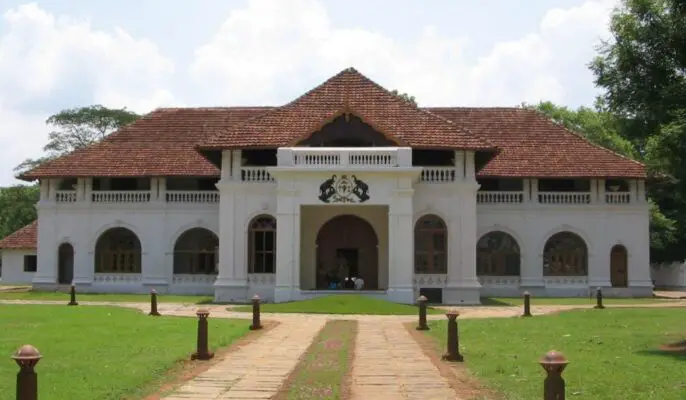
Immerse yourself in history at the Mattancherry Palace, also known as the Dutch Palace, showcasing Kerala murals and artifacts that tell the tale of Kochi’s royal past.
Nestled in the heart of Mattancherry, a quaint neighborhood in Kochi, the Mattancherry Palace, also known as the Dutch Palace, stands as a testament to the opulent history and cultural richness of this vibrant city. With its exquisite architecture and a treasure trove of historical artifacts, the palace is a must-visit destination for those seeking a journey back in time.
Historical Overview:
Built by the Portuguese in 1555, the Mattancherry Palace underwent significant renovations by the Dutch in 1663, earning it the moniker “Dutch Palace.” The palace served as a gift to the Raja of Kochi in exchange for trading privileges.
Architectural Splendor:
The architectural style of Mattancherry Palace reflects a blend of traditional Kerala architecture with colonial influences. The gabled roofs, wooden ceilings, and spacious courtyards are a visual feast for architecture enthusiasts.
Frescoed Walls:
One of the highlights of the palace is the remarkable collection of murals that adorn the walls. The intricately detailed frescoes depict scenes from the Ramayana, Mahabharata, and other mythological tales, providing a captivating glimpse into Kerala’s cultural and artistic heritage.
Royal Collection:
Mattancherry Palace houses an impressive array of artifacts, including royal portraits, weaponry, and paraphernalia belonging to the Cochin royal family. The exhibits offer a rare insight into the regal lifestyle and traditions of the bygone era.
A Blend of Cultures:
While the palace is predominantly associated with Dutch architecture, it also features elements of Portuguese and traditional Kerala styles. This unique amalgamation makes Mattancherry Palace a symbol of the multicultural influences that have shaped Kochi over the centuries.
Palace Courtyards:
Wander through the expansive courtyards of the palace, where you’ll find well-maintained gardens and ancient trees providing shade. The serene ambiance adds to the overall charm, creating a tranquil escape within the bustling city.
Adjacent Temples:
Mattancherry Palace is surrounded by several historically significant temples, adding to the spiritual aura of the area. The proximity to these temples enhances the cultural experience for visitors exploring the palace.
Visiting Tips:
When planning your visit, consider exploring Mattancherry Palace along with nearby attractions such as the Jew Town and the Paradesi Synagogue to make the most of your time in this historically rich neighborhood.
A visit to Mattancherry Palace is a captivating journey through Kochi’s royal history, where the echoes of the past resonate in every architectural detail and historical artifact. The palace stands as a living testament to the cultural fusion that defines Kochi, inviting travelers to immerse themselves in the grandeur of a bygone era while marveling at the timeless beauty that Mattancherry Palace continues to exude.
Jew Town and Synagogue:
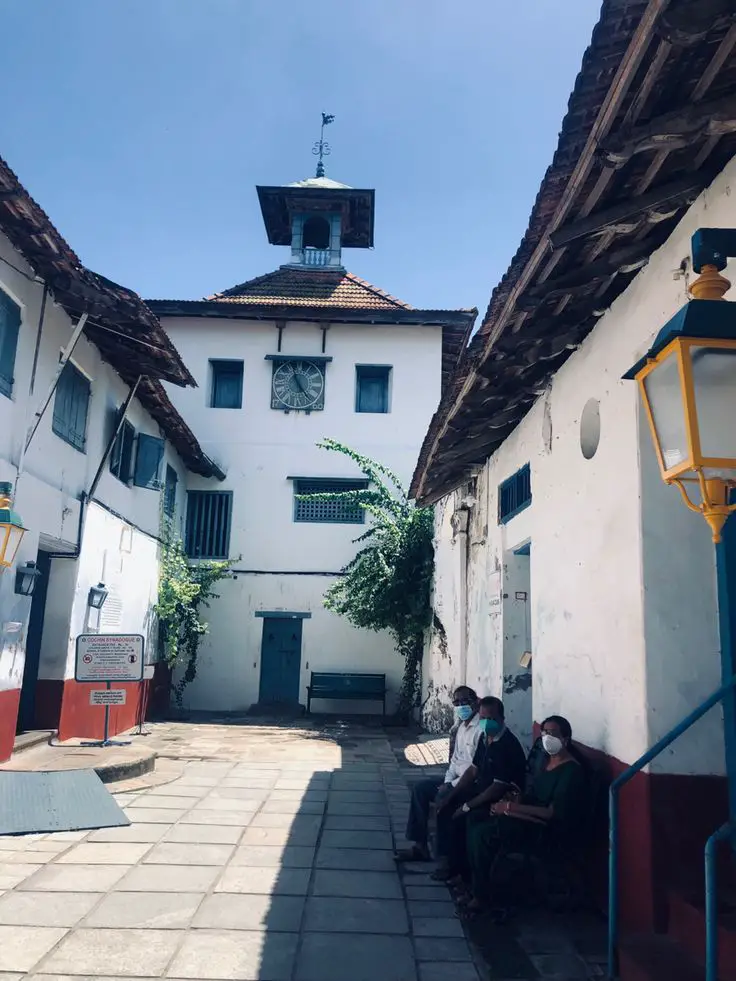
Wander through Jew Town’s narrow lanes, explore antique shops, and visit the Jewish Synagogue, the oldest in the Commonwealth.Kochi, a city steeped in history and cultural diversity, is home to Jew Town, a vibrant neighborhood that tells the tales of a bygone era. At the heart of this enclave stands the Paradesi Synagogue, a jewel in Kochi’s cultural crown. Join us on a journey through the narrow lanes of Jew Town and the historical significance of the Paradesi Synagogue.
Historical Mosaic:
Jew Town, located in the Mattancherry area, is a living testament to the multicultural history of Kochi. The neighborhood got its name due to the thriving Jewish community that once called this place home, creating a unique blend of Jewish, Portuguese, Dutch, and Indian influences.
Paradesi Synagogue:
At the heart of Jew Town stands the Paradesi Synagogue, a symbol of Kochi’s syncretic past. Built in 1568, it is the oldest active synagogue in the Commonwealth. The word “Paradesi” means foreigner, emphasizing the foreign origin of the Jews who built and worshiped in this historic synagogue.
Architectural Marvel:
The Paradesi Synagogue is a masterpiece of architecture, featuring a mix of traditional Malabari, Dutch, and Colonial styles. The interiors are adorned with hand-painted Chinese tiles, Belgian chandeliers, and a unique clock tower, creating a captivating blend of cultural elements.
Jewish Artifacts:
Within the synagogue, you’ll find a treasure trove of Jewish artifacts, including ancient scrolls, copper plates, and intricately crafted gold and silver ornaments. Each item narrates a story of the Jewish community’s resilience and their harmonious coexistence with the diverse cultures of Kochi.
Jew Town Bazaar:
Stroll through the vibrant Jew Town Bazaar, where the air is filled with the aroma of spices, antique shops line the streets, and the echoes of history resonate in every corner. The bazaar offers a delightful shopping experience, with a variety of curios, spices, and traditional souvenirs.
Mattancherry Spice Market:
While exploring Jew Town, don’t miss the opportunity to visit the Mattancherry Spice Market. Immerse yourself in the rich aromas of spices like cardamom, cinnamon, and pepper, showcasing Kochi’s historical role as a spice trading hub.
Cochin Spice Route Restaurant:
Indulge in the diverse flavors of Kochi by dining at one of the many restaurants in Jew Town. The Cochin Spice Route Restaurant offers a culinary journey through the region’s rich spice-infused cuisine.
Harmony in Diversity:
The story of Jew Town and the Paradesi Synagogue is a testament to the harmonious coexistence of diverse communities in Kochi. The neighborhood reflects a unique chapter in history where people from different backgrounds lived, traded, and celebrated together.
Santa Cruz Basilica:
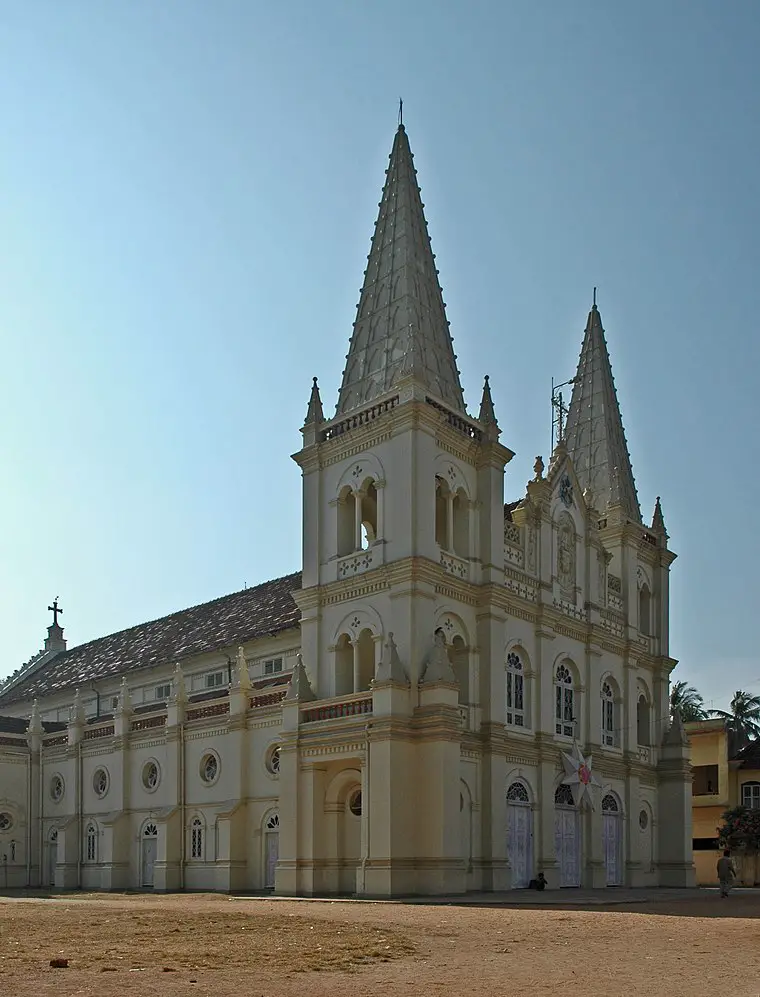
Marvel at the architectural beauty of Santa Cruz Basilica, a historic church that stands as a testament to Kochi’s colonial influences.Nestled in the heart of Fort Kochi, Santa Cruz Basilica stands as a magnificent testament to Kochi’s rich religious and architectural heritage. With its awe-inspiring structure and a history that spans centuries, this basilica is a spiritual beacon that beckons visitors from around the world to immerse themselves in the divine charm it exudes.
Colonial Marvel:
Constructed by the Portuguese in the late 15th century, Santa Cruz Basilica is one of the eight basilicas in India. Its architectural grandeur reflects a harmonious blend of Indo-European styles, showcasing the influence of the Portuguese colonizers on the sacred landscape of Kochi.
Historical Significance:
Santa Cruz Basilica has witnessed the ebb and flow of Kochi’s history. Originally built by the Portuguese, it was later destroyed by the British in 1795 during the Battle of Kochi. The current structure, standing since its reconstruction in the 19th century, narrates tales of resilience and spiritual revival.
Gothic Splendor:
The basilica’s interior is adorned with strikingly beautiful Gothic-style arches, intricate paintings, and a stunning wooden ceiling. The grandeur of the altar, embellished with gold and adorned with intricate carvings, adds to the ethereal ambiance within the basilica.
Stained Glass Windows:
One of the highlights of Santa Cruz Basilica is its exquisite stained glass windows. These vibrant windows depict scenes from the Bible and add a kaleidoscopic touch to the interior, creating an atmosphere of divine transcendence.
Religious Relics:
The basilica houses several religious relics, including a fragment of the True Cross of Christ, making it an important pilgrimage site for the Christian community. The sacred artifacts and religious symbolism within the basilica contribute to its significance as a center of faith.
Religious Festivals:
Santa Cruz Basilica comes alive during religious festivals, particularly during the annual Santa Cruz Feast. Pilgrims and tourists gather to witness the grand processions, cultural performances, and religious ceremonies that mark these celebrations.
Santa Cruz Cathedral Basilica Parish Hall:
Adjacent to the basilica is the Parish Hall, a cultural and educational center that adds to the community spirit surrounding Santa Cruz Basilica. The hall hosts various events, exhibitions, and activities that contribute to the local cultural landscape.
Tranquil Courtyard:
Outside the basilica lies a peaceful courtyard, offering visitors a serene space for reflection and prayer. The well-maintained gardens and the serene ambiance create a conducive environment for moments of quiet contemplation.
Santa Cruz Basilica, with its majestic architecture and deep-rooted history, is not just a religious landmark but a living testament to the enduring spirit of Kochi. Whether you seek spiritual solace, cultural enrichment, or simply appreciate architectural marvels, a visit to Santa Cruz Basilica is a journey through time, allowing you to witness the convergence of faith, history, and art in the heart of Fort Kochi.
Cherai Beach, Kochi: A Tranquil Oasis on the Malabar Coast
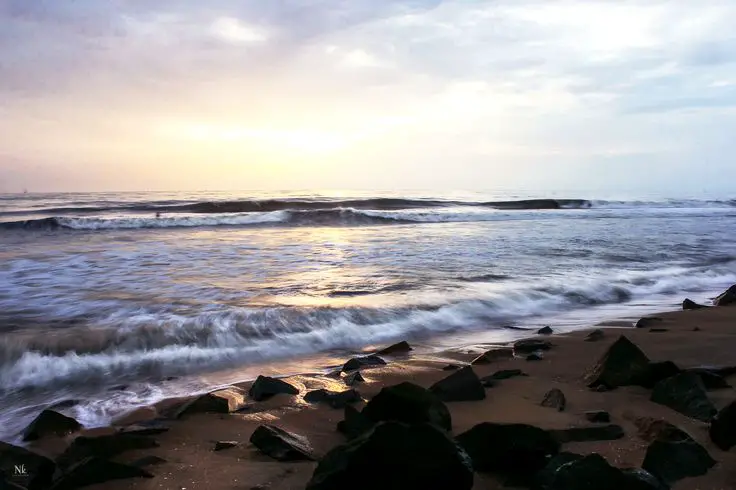
Nestled along the picturesque Malabar Coast, Cherai Beach in Kochi is a hidden gem waiting to be discovered. With its pristine shores, gentle waves, and a backdrop of coconut groves, Cherai Beach offers an idyllic escape for those seeking serenity and natural beauty. Let’s embark on a journey to explore the charm of Cherai Beach in Kochi.
Golden Sands and Azure Waters:
Cherai Beach welcomes visitors with stretches of golden sands that gently caress the azure waters of the Arabian Sea. The soft sands make for a perfect spot to unwind, bask in the sun, or take leisurely strolls along the shoreline.
Calm and Safe Waters:
The beach’s gentle waves and shallow waters make it an ideal destination for families and those seeking a relaxed swimming experience. The calm sea allows visitors to enjoy the water without the strong currents often found in other coastal areas.
Unique Seashells:
Cherai Beach is known for its collection of unique seashells scattered along the shore. Seashell enthusiasts and beachcombers can indulge in collecting these natural treasures, adding an extra layer of charm to their beachside experience.
Vibrant Local Life:
As you stroll along Cherai Beach, you’ll encounter the vibrant local life of fishermen going about their daily activities. Witnessing the rhythmic pull of Chinese fishing nets and the colorful boats against the horizon adds an authentic touch to your coastal retreat.
Scenic Backdrop of Coconut Groves:
Cherai Beach is flanked by lush coconut groves, providing a scenic backdrop to the coastal landscape. The swaying palms create a tropical ambiance, casting shade on the beach and offering a respite from the sun.
Dolphin Watching:
Cherai Beach is known for occasional dolphin sightings. Adventurous souls can embark on boat trips from the nearby Cochin Backwaters for a chance to witness these playful creatures in their natural habitat.
Water Sports and Activities:
Thrill-seekers can engage in various water sports and activities offered along Cherai Beach. From parasailing to jet-skiing, the beach provides an opportunity for adrenaline-pumping adventures against the backdrop of the Arabian Sea.
Cafes and Shacks:
The beachfront is dotted with charming cafes and shacks serving delectable seafood and local delicacies. Enjoying a meal with the sound of waves in the background enhances the overall culinary experience.
Cherai Beach in Kochi is not just a destination; it’s a haven where nature’s beauty meets the tranquility of the Arabian Sea. Whether you seek relaxation, water adventures, or a peaceful escape, Cherai Beach offers a perfect blend of coastal charm and scenic wonders, making it a must-visit destination for anyone exploring the enchanting city of Kochi.
Dutch Cemetery:
Pay respects to the city’s history at the Dutch Cemetery, a somber yet fascinating site that echoes tales of Kochi’s colonial past.Nestled in the historic precincts of Fort Kochi, the Dutch Cemetery stands as a silent testament to the colonial chapters that unfolded on the Malabar Coast. This serene burial ground, shaded by ancient trees, serves as a poignant reminder of Kochi’s colonial history and the lives that once thrived within its walls.
Colonial Legacy:
The Dutch Cemetery, dating back to the era of Dutch East India Company’s influence in the region, reflects the colonial footprint left on Kochi’s shores. Established in the mid-18th century, the cemetery was used by the Dutch colonizers to inter their prominent merchants, officials, and military personnel.
Architectural Elegance:
The cemetery’s architecture is a blend of colonial aesthetics and local influences. Ornate tombstones, some weathered with time, bear intricate carvings and inscriptions, offering a glimpse into the artistic expressions of the colonial period.
Historical Significance:
Each gravestone at the Dutch Cemetery narrates a unique story, unraveling the lives of those who once called Kochi home. The cemetery holds the remains of Dutch commanders, officials, and even their families, immortalizing their contributions to Kochi’s colonial past.
Multicultural Reflections:
The Dutch Cemetery is not only a resting place for Dutch nationals but also holds the graves of individuals from different cultural backgrounds, highlighting the cosmopolitan nature of Kochi during the colonial era.
Well-Maintained Grounds:
The cemetery’s grounds, adorned with mature trees and well-maintained pathways, create a serene ambiance. Visitors can take a contemplative stroll through the silent avenues, paying homage to the souls that found their final repose within this historic enclosure.
Colonial Symbols:
The tombstones feature symbols and motifs that were characteristic of the colonial period. Winged skulls, cherubs, and other emblematic figures evoke a sense of nostalgia and add to the historical richness of the Dutch Cemetery.
Cultural Preservation:
Efforts to preserve the Dutch Cemetery highlight Kochi’s commitment to safeguarding its cultural heritage. Conservation initiatives ensure that future generations can continue to explore this colonial relic and understand its significance in the broader historical context.
Visiting with Respect:
Visitors to the Dutch Cemetery are encouraged to approach with a sense of reverence. The tranquil surroundings create an atmosphere conducive to reflection and remembrance, allowing individuals to connect with the narratives etched into the tombstones.
The Dutch Cemetery in Kochi stands as a silent witness to the ebb and flow of colonial powers that shaped the destiny of this coastal city. In the shadow of the ancient trees and amidst the weathered tombstones, the cemetery invites contemplation, urging visitors to acknowledge and appreciate the intricate layers of history that lie beneath the surface of modern-day Kochi.
Kochi Biennale:
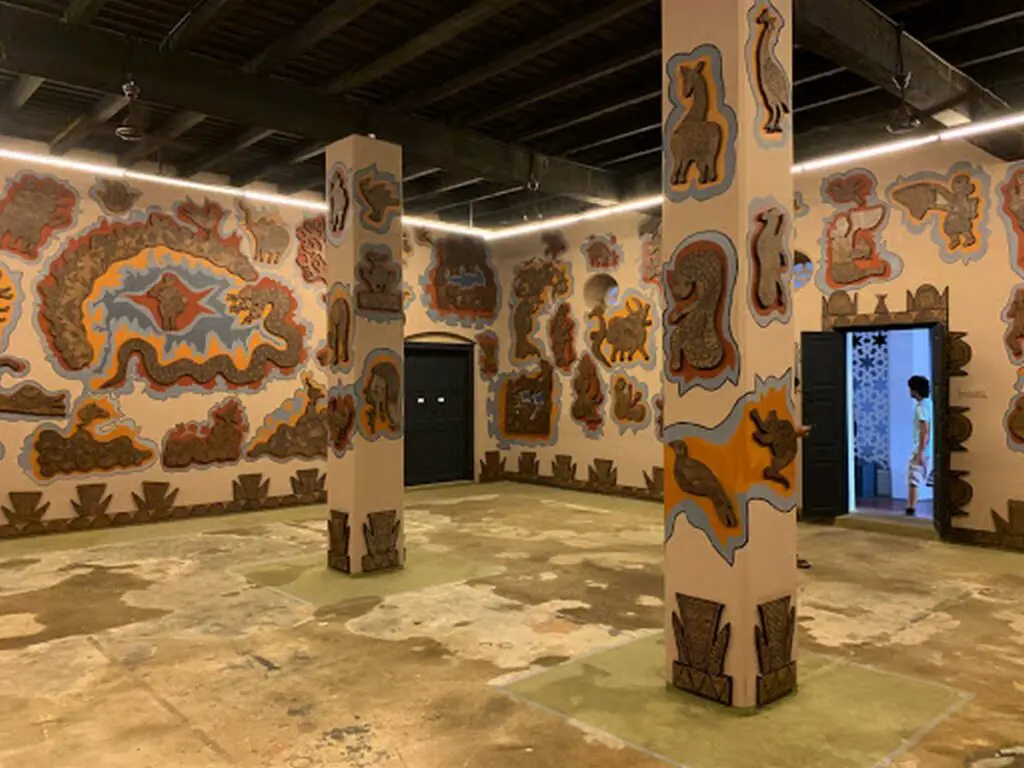
If you visit during the biennale, experience the vibrant art scene as contemporary artists from around the world showcase their works at various venues across the city.Kochi, a city steeped in history and culture, transforms into a vibrant canvas every two years during the Kochi-Muziris Biennale. This dynamic art exhibition has become a cultural phenomenon, attracting artists, enthusiasts, and curious minds from around the world. Let’s delve into the kaleidoscope of creativity that is the Kochi Biennale.
Inception and Vision:
The Kochi Biennale was inaugurated in 2012 as an initiative to bring contemporary art to the forefront in India. Conceived by artists Riyas Komu and Bose Krishnamachari, the biennale aimed to create a platform for diverse artistic expressions and foster a global dialogue on contemporary issues through art.
Venues Across Kochi:
One of the unique aspects of the Kochi Biennale is its decentralization across various venues, from heritage buildings to galleries and public spaces. This approach not only showcases the rich architectural heritage of Kochi but also allows visitors to explore the city while engaging with contemporary art.
International and Indian Artists:
The biennale curators meticulously curate a roster of both international and Indian artists, creating a melting pot of artistic perspectives. This fusion of diverse voices results in an exhibition that transcends geographical boundaries, offering a global panorama of contemporary art.
Multidisciplinary Art Forms:
Kochi Biennale is not confined to traditional mediums; it embraces a wide array of art forms, including visual arts, installations, performances, new media, and more. This multidisciplinary approach challenges both artists and viewers to think beyond conventional boundaries.
Community Engagement:
Beyond the confines of galleries, the biennale actively engages with the local community. Artists often collaborate with residents, and installations can be found in public spaces, creating an immersive experience that encourages dialogue and connection.
Art and Social Commentary:
Many artworks presented at the Kochi Biennale delve into pressing social and political issues. The artists use their creations as a powerful medium to communicate messages, provoke thought, and initiate discussions on topics ranging from identity and migration to environmental concerns.
Workshops and Events:
The biennale extends its impact through educational workshops, seminars, and events that provide a platform for dialogue and learning. These initiatives aim to bridge the gap between the art world and the general public, fostering a deeper understanding and appreciation of contemporary art.
Legacy and Global Recognition:
Over the years, the Kochi Biennale has gained international acclaim, solidifying its place as one of the most significant art events in the world. Its legacy extends beyond the exhibition period, influencing the cultural landscape of Kochi and contributing to the city’s identity as a hub for contemporary art.
The Kochi Biennale transcends the traditional boundaries of art, transforming Kochi into a dynamic and ever-evolving cultural hub. By celebrating diversity, encouraging dialogue, and embracing various artistic expressions, the biennale not only enriches the artistic community but also invites visitors to explore the profound connections between art, society, and the vibrant city of Kochi.
Veeran Puzha Beach:
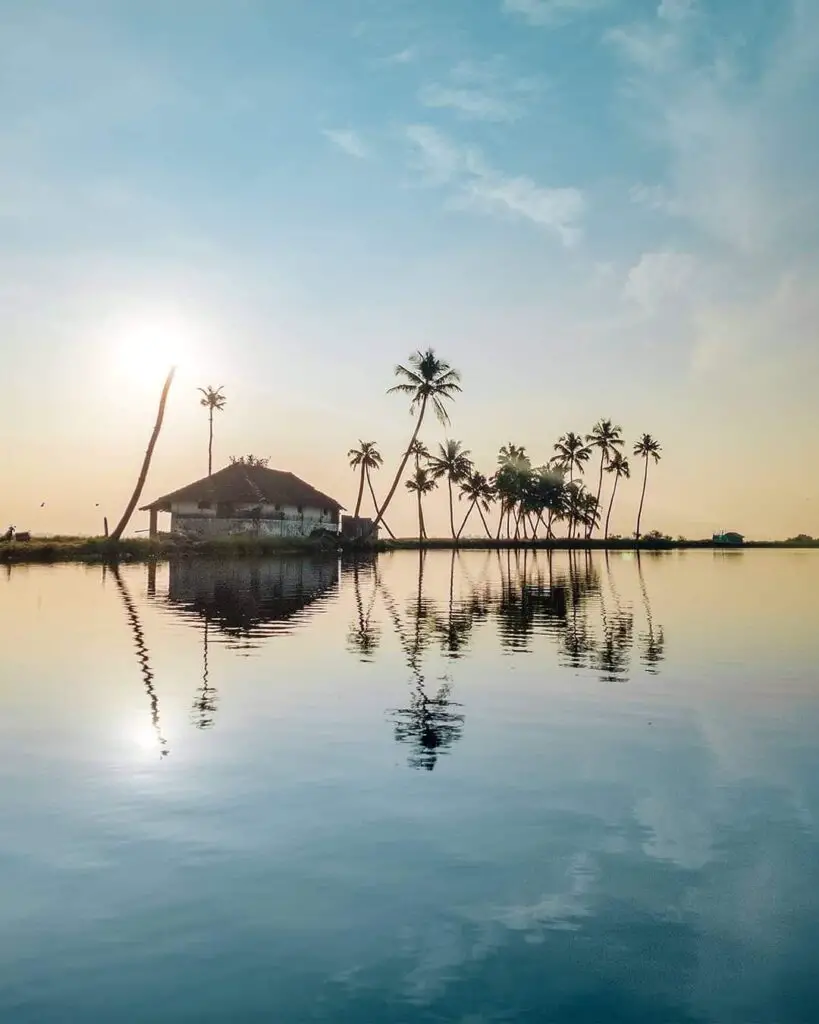
Discover the hidden gem of Veeranpuzha Beach, a less crowded alternative with pristine shores and a serene ambiance.
Tucked away from the bustling crowds and known only to those seeking serenity, Veeranpuzha Beach stands as a hidden gem on the Malabar Coast. With its pristine shores, tranquil waters, and unspoiled beauty, this lesser-known beach offers a haven for those yearning for a peaceful escape. Let’s embark on a journey to discover the enchantment of Veeranpuzha Beach.
Secluded Tranquility:
Unlike its more popular counterparts, Veeranpuzha Beach is a secluded haven that remains untouched by the tourist rush. The calmness of the surroundings creates an atmosphere of tranquility, making it an ideal destination for those seeking solace by the sea.
Pristine Golden Sands:
The beach boasts long stretches of pristine golden sands, providing a picturesque canvas against the backdrop of the Arabian Sea. The soft sands invite visitors to take leisurely strolls, feel the gentle caress of the sea breeze, or simply unwind in the lap of nature.
Panoramic Views:
Veeran Puzha Beach offers breathtaking panoramic views of the Arabian Sea. The unobstructed horizon allows visitors to witness stunning sunrises and sunsets, casting a warm glow over the tranquil waters and creating a mesmerizing tapestry of colors.
Less Crowded Atmosphere:
One of the unique aspects of Veeranpuzha Beach is its relative lack of crowds. The serene ambiance allows visitors to connect with nature, listen to the rhythmic sounds of the waves, and appreciate the beauty of the coastline without the distractions of a bustling crowd.
Fishing Villages Nearby:
The beach is surrounded by quaint fishing villages, providing a glimpse into the authentic coastal life of Kerala. Visitors can observe local fishermen going about their daily routines, creating a harmonious blend of nature and culture.
Birdwatcher’s Paradise:
Veeran Puzha Beach is a haven for birdwatchers, with its proximity to the backwaters and estuaries. The coastal ecosystem attracts a variety of bird species, making it an ideal spot for those interested in observing avian life in its natural habitat.
Boat Rides and Backwaters:
Explore the enchanting backwaters near Veeran puzha Beach by taking a peaceful boat ride. The backwaters offer a different perspective, allowing visitors to witness the lush greenery and tranquility of Kerala’s coastal landscape.
Local Flavors and Cuisine:
While at Veeranpuzha Beach, visitors can savor the local flavors of coastal Kerala. Fresh seafood, coconut-infused dishes, and traditional delicacies are readily available in the nearby fishing villages, providing an authentic culinary experience.
Veeran Puzha Beach, with its secluded charm and unspoiled beauty, offers a retreat from the ordinary. For those seeking a quiet escape along the Malabar Coast, this hidden gem invites you to embrace the simplicity of nature, listen to the soothing sounds of the sea, and savor the tranquility that defines Veeran Puzha Beach.
Hill Palace Museum:
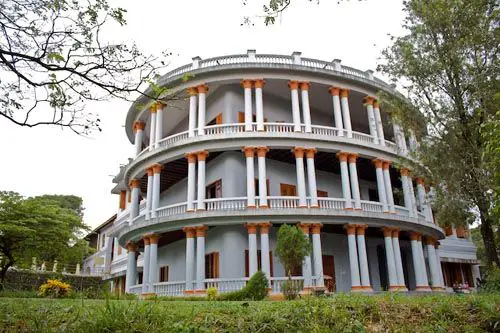
Explore the Hill Palace Museum, the largest archaeological museum in Kerala, displaying artifacts from the royal family of Kochi.Nestled amid the lush greenery of Tripunithura, the Hill Palace Museum stands as a majestic testament to the royal heritage of Kerala. With its sprawling grounds, intricate architecture, and an extensive collection of artifacts, the museum provides a captivating journey into the opulent past of the region. Let’s explore the regal allure and cultural richness encapsulated within the walls of the Hill Palace Museum.
Historical Opulence:
- Constructed in 1865, the Hill Palace served as the residence of the Maharaja of Cochin and was later converted into the first heritage museum in Kerala. Its regal architecture, reminiscent of traditional Kerala style, echoes the grandeur of the royal era.
Architectural Marvels:
- The Hill Palace Museum boasts a harmonious blend of traditional and colonial architectural styles. The palace complex includes multiple wings, each showcasing distinctive features such as sloping roofs, wooden beams, and intricately carved details that transport visitors back in time.
Keralan Murals:
- Step into a world of vibrant artistry as the museum houses a remarkable collection of Keralan murals. These exquisite paintings depict scenes from epics like the Ramayana and Mahabharata, showcasing the rich cultural and artistic heritage of Kerala.
Antique Furnishings:
- The Hill Palace Museum is adorned with a remarkable array of antique furnishings, including royal beds, ornate furniture, and regal artifacts. Each piece narrates a story of the royal lifestyle, offering a glimpse into the opulence that characterized the lives of the Cochin Maharajas.
Royal Collections:
- Wander through the various galleries to witness the extensive royal collections on display. From rare manuscripts and ancient coins to vintage weaponry and traditional Kerala musical instruments, the Hill Palace Museum encapsulates the diversity of the region’s historical treasures.
Ethnographic Displays:
- The museum goes beyond the royal artifacts to showcase the ethnographic diversity of Kerala. Visitors can explore exhibits on traditional art forms, ritualistic objects, and artifacts that illuminate the cultural mosaic of the state.
Archaeological Park:
- The Hill Palace Museum extends beyond its walls into an archaeological park. The park features ancient megalithic structures, rock-cut caves, and prehistoric artifacts, providing visitors with an immersive experience of Kerala’s archaeological wealth.
Tripunithura Folklore Museum:
- Within the palace complex, the Tripunithura Folklore Museum adds another layer to the cultural tapestry. It houses a rich collection of folklore and traditional art, preserving the essence of Kerala’s oral traditions and storytelling.
The Hill Palace Museum, with its regal architecture and diverse collections, stands as a beacon of Kerala’s rich history and cultural heritage. A visit to this magnificent institution is not just a journey through time but an opportunity to appreciate the opulence, artistry, and traditions that have shaped the royal legacy of Kerala. The museum’s commitment to preserving and presenting this heritage ensures that the Hill Palace remains a cultural treasure for generations to come.
Kochi Maritime Museum:
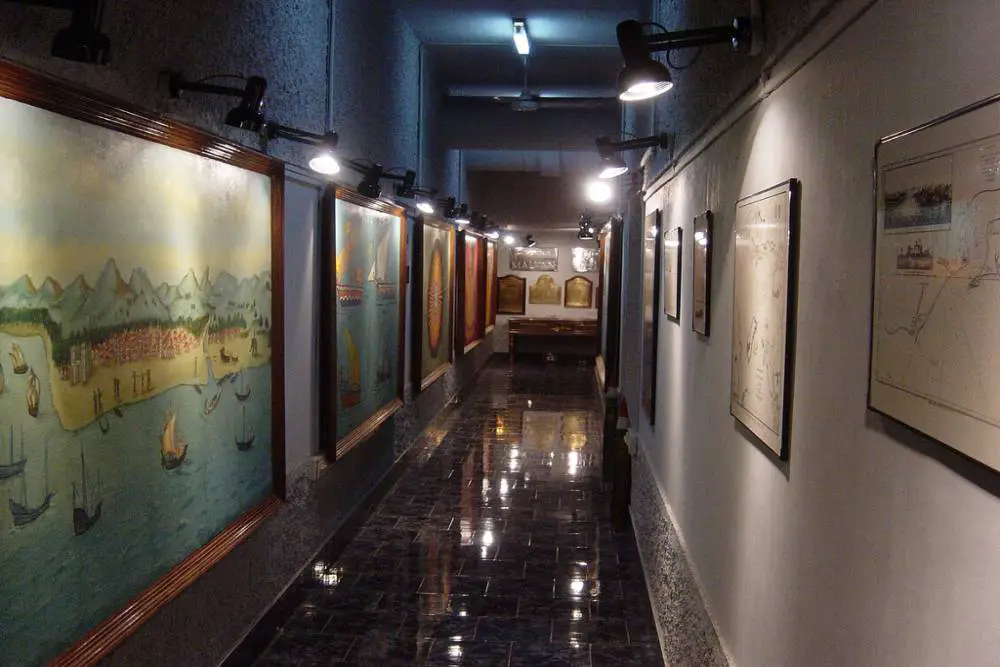
Gain insights into Kochi’s maritime history at the Kochi Maritime Museum, featuring exhibits on shipbuilding, navigation, and trade.In the heart of the coastal city of Kochi, the Maritime Museum stands as a testament to the region’s deep-rooted maritime heritage. Nestled amidst the enchanting landscapes of Fort Kochi, this museum unravels the captivating tales of seafaring, trade, and the maritime prowess that defined Kochi’s historical identity. Let’s embark on a maritime journey through time as we explore the treasures housed within the Kochi Maritime Museum.
Gateway to the Sea:
Kochi, with its strategic location along the Arabian Sea, has been a vital port of call for centuries. The Maritime Museum serves as a gateway to the sea, inviting visitors to delve into the maritime history that shaped the destiny of this coastal city.
Historical Significance:
Housed in the INS Dronacharya naval base, the Kochi Maritime Museum showcases the maritime exploits of Kochi from ancient times to the present day. It pays homage to the city’s maritime pioneers, explorers, and traders who contributed to its rich legacy.
Antique Maritime Artifacts:
The museum’s galleries are adorned with a fascinating collection of maritime artifacts, including ancient navigational instruments, ship models, and artifacts salvaged from shipwrecks. These exhibits provide insights into the seafaring technologies and maritime practices of bygone eras.
Evolution of Navigation:
Visitors can trace the evolution of navigation tools and equipment, witnessing the transition from traditional methods to modern technology. The museum showcases how sailors relied on astrolabes, compasses, and nautical charts, highlighting the ingenuity of seafarers throughout history.
Ship Models and Vessels:
A highlight of the Kochi Maritime Museum is the impressive array of ship models and vessels on display. From ancient trade ships to modern naval vessels, these meticulously crafted models offer a visual narrative of the diverse maritime activities that have shaped Kochi’s coastal landscape.
Interactive Exhibits:
The museum takes a modern approach to storytelling with interactive exhibits that engage visitors of all ages. Touch-screen displays, audio-visual presentations, and virtual simulations provide an immersive experience, making the maritime history of Kochi come alive.
Role in Naval Warfare:
Explore the pivotal role that Kochi played in naval warfare through the ages. Displays featuring naval armaments, warship models, and narratives of historical naval conflicts offer a glimpse into the strategic importance of the city’s maritime prowess.
Preserving Nautical Heritage:
The Kochi Maritime Museum serves as a custodian of nautical heritage, aiming to preserve and promote awareness of the maritime legacy that defines Kochi. Educational programs, workshops, and outreach initiatives contribute to fostering an appreciation for maritime history among the public.
The Kochi Maritime Museum, with its blend of historical artifacts and modern interactive exhibits, is a maritime odyssey that brings to life the seafaring tales of Kochi. As visitors navigate through the museum’s galleries, they embark on a voyage through time, gaining a profound understanding of how the maritime heritage of Kochi has left an indelible mark on the city’s cultural and historical tapestry.
Mangalavanam Bird Sanctuary:
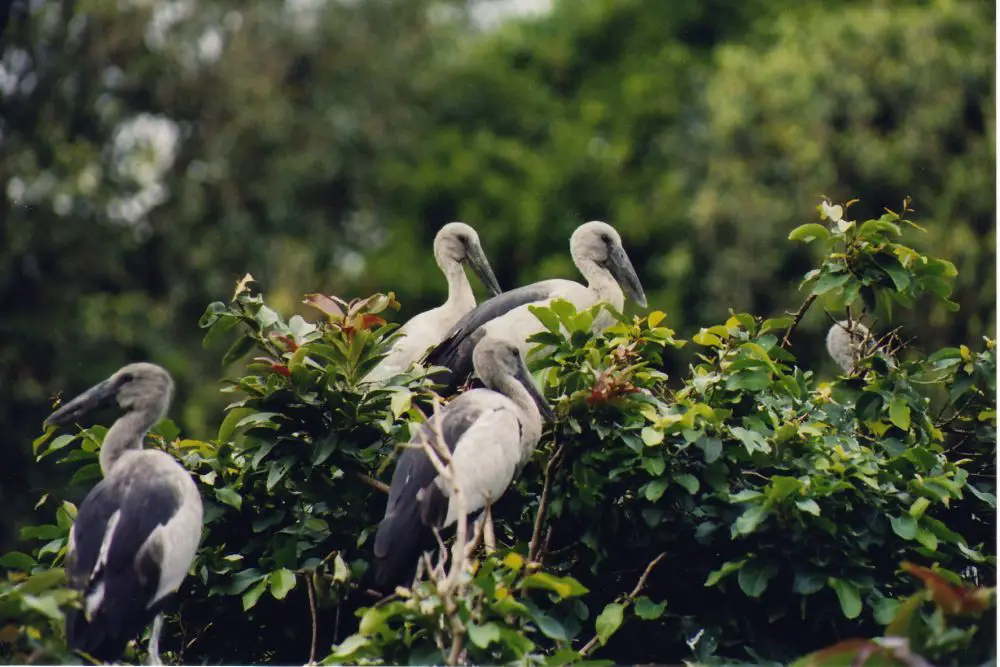
Nature enthusiasts will appreciate the Mangalavanam Bird Sanctuary, a green oasis in the heart of Kochi, home to a variety of bird species.Nestled in the heart of Kochi, Mangalavanam Bird Sanctuary stands as a lush green refuge amidst the urban landscape. This serene sanctuary, often referred to as the ‘green lung of Kochi,’ is a haven for bird enthusiasts, nature lovers, and those seeking solace in the midst of the bustling city. Let’s unravel the enchanting narrative of Mangalavanam, where nature’s symphony takes center stage.
Urban Oasis:
Tucked away in the midst of the concrete jungle, Mangalavanam Bird Sanctuary provides a breath of fresh air. Its existence serves as a reminder of the importance of preserving natural habitats within urban environments.
Flora Diversity:
The sanctuary is a vibrant tapestry of flora, featuring a variety of mangrove species, trees, and aquatic plants. The lush greenery creates a refreshing environment that attracts not only birds but also butterflies and other wildlife.
Avian Abundance:
Mangalavanam is renowned for its rich avian biodiversity. The sanctuary hosts a plethora of resident and migratory bird species, making it a paradise for bird watchers. Spotting vibrant kingfishers, majestic egrets, and rare migratory birds is a common occurrence within the sanctuary’s bounds.
Migratory Marvels:
Mangalavanam serves as a pitstop for migratory birds along the international bird migration route. During the migratory season, the sanctuary becomes a temporary home for species like pintails, garganeys, and marsh sandpipers, adding an international flair to its avian population.
Pristine Ponds:
The sanctuary features pristine ponds and water bodies that provide a habitat for both resident and migratory birds. The reflections of the surrounding greenery on the tranquil waters create a picturesque setting for bird watching and nature appreciation.
Nature Trails:
Visitors can explore well-maintained nature trails that wind through the sanctuary, offering an immersive experience in the heart of nature. The trails provide glimpses of various bird species and the opportunity to appreciate the sanctuary’s biodiversity up close.
Conservation Efforts:
Mangalavanam plays a crucial role in conservation efforts, particularly in preserving the habitat of endangered bird species. The sanctuary actively engages in initiatives to protect the delicate ecosystem, ensuring the well-being of its avian residents.
Educational Initiatives:
Recognizing the importance of environmental education, Mangalavanam conducts awareness programs and guided tours. These initiatives aim to foster an understanding of the significance of biodiversity conservation and the role each person can play in preserving natural habitats.
Mangalavanam Bird Sanctuary, with its harmonious blend of urban life and natural beauty, stands as a testament to the coexistence of man and nature. As a sanctuary for avian wonders and a respite for weary city dwellers, Mangalavanam invites everyone to step into its green embrace, listen to the melodies of its feathered residents, and contribute to the collective effort of safeguarding the precious biodiversity within our cities.
Bolgatty Palace:
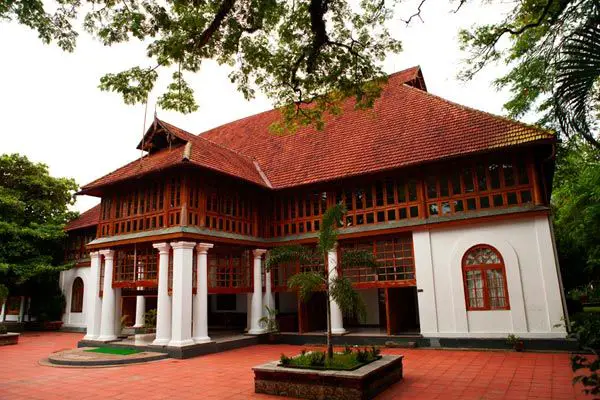
Enjoy a luxurious retreat at Bolgatty Palace, a heritage hotel set amidst lush greenery, offering a glimpse into Kochi’s regal past.Nestled on the scenic Bolgatty Island in the heart of Kochi, Bolgatty Palace stands as a magnificent testimony to Kerala’s colonial past and regal heritage. With its lush surroundings, historic architecture, and a captivating view of the Arabian Sea, Bolgatty Palace offers a royal retreat for those seeking a glimpse into the opulent history of this coastal city.
Colonial Legacy:
Bolgatty Palace, built by the Dutch in 1744, holds a unique position as one of the oldest existing Dutch palaces outside the Netherlands. Over the centuries, it underwent transformations under British rule and later served as the residence of the British Governors, adding layers of colonial history to its architectural charm.
Architectural Grandeur:
The palace showcases a captivating blend of Dutch and traditional Kerala architectural styles. With its sloping roofs, large windows, and wooden façade, Bolgatty Palace exudes an old-world charm that transports visitors to an era of colonial splendor.
Pristine Gardens:
Surrounding the palace are meticulously maintained gardens that add to its regal ambiance. The manicured lawns, vibrant flower beds, and ancient trees create a tranquil setting, making it an ideal place for leisurely strolls and moments of reflection.
Bolgatty Island Resort:
Today, Bolgatty Palace has been transformed into a premium heritage hotel – the Bolgatty Island Resort. The palace’s interiors have been carefully restored to preserve its historical essence, offering guests a chance to experience the regal lifestyle of the past with modern amenities.
Scenic Golf Course:
The palace complex boasts an expansive golf course, offering breathtaking views of the backwaters and the city skyline. Golf enthusiasts can enjoy a round of golf amidst the serene surroundings, creating a unique blend of leisure and luxury.
St. Francis Church and Bolgatty Event Center:
Adjacent to the palace stands the St. Francis Church, a Dutch-era church that adds to the historical charm of the region. Additionally, the Bolgatty Event Center within the palace premises serves as a venue for weddings, conferences, and cultural events, further contributing to the palace’s vibrant ambiance.
Culinary Delights:
Guests at Bolgatty Island Resort can savor a delectable array of culinary delights. The on-site restaurants serve a mix of local and international cuisine, allowing visitors to indulge in a gastronomic journey within the regal confines of the palace.
Accessibility and Tranquility:
Despite its central location in Kochi, Bolgatty Palace offers a serene escape from the urban hustle. Accessible by a short ferry ride, the island provides a peaceful retreat where guests can unwind, surrounded by the beauty of nature and history.
Bolgatty Palace stands as a living testament to Kochi’s rich history, seamlessly blending colonial aesthetics with the timeless allure of Kerala’s traditional architecture. Whether you’re a history enthusiast, a nature lover, or a traveler seeking a luxurious escape, Bolgatty Palace welcomes you to immerse yourself in the regal elegance that defines this iconic landmark on the shores of Kochi.
Kumbalangi Integrated Tourism Village:
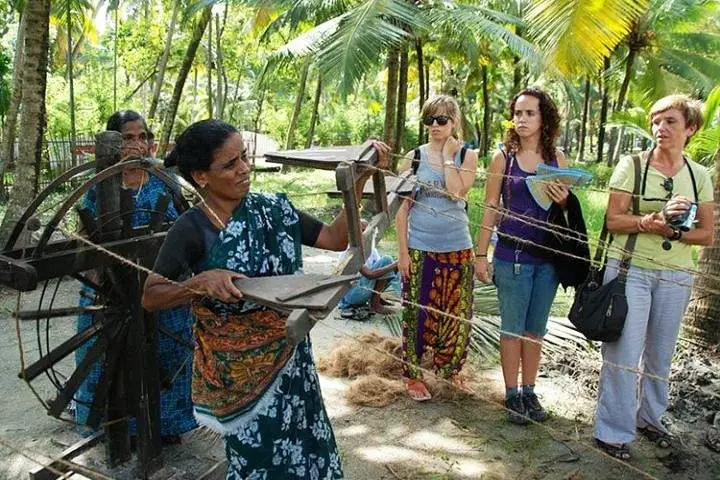
Experience sustainable tourism at Kumbalangi, a model fishing village that provides a unique insight into the local way of life.Nestled along the tranquil backwaters of Kochi, the Kumbalangi Integrated Tourism Village stands as a model of sustainable tourism, offering visitors a unique blend of cultural immersion and eco-friendly experiences. This picturesque village, situated on the Kumbalangi island, is a testament to Kerala’s commitment to responsible tourism and community development. Let’s explore the harmonious tapestry woven by Kumbalangi, where tradition, nature, and hospitality converge.
Eco-Friendly Haven:
Kumbalangi takes pride in its eco-friendly initiatives, making it a haven for nature enthusiasts. The village promotes responsible tourism practices, including waste management, renewable energy sources, and sustainable agriculture, creating a model for eco-conscious travelers.
Cultural Immersion:
The village offers a unique opportunity to immerse yourself in the local way of life. Visitors can interact with the residents, witness traditional art forms, and partake in cultural activities that provide insights into the rich heritage of Kerala.
Chinese Fishing Nets:
Witness the iconic Chinese fishing nets along the backwaters, a sight synonymous with Kerala’s coastal landscape. The residents of Kumbalangi continue the age-old tradition of using these nets for their livelihood, offering visitors a glimpse into the region’s maritime heritage.
Homestay Experience:
Kumbalangi takes pride in its community-driven homestay initiatives. Visitors have the opportunity to stay with local families, experiencing genuine hospitality, indulging in home-cooked meals, and gaining a deeper understanding of the daily lives of the village residents.
Art and Craft:
The village is a hub of traditional arts and crafts. Local artisans showcase their skills in coir weaving, mat making, and pottery. Visitors can engage in hands-on experiences, creating their own souvenirs while supporting the local craftsmen.
Backwater Cruises:
Explore the pristine backwaters of Kumbalangi on a tranquil boat cruise. The guided tours offer breathtaking views of the mangrove forests, lush greenery, and a chance to spot diverse bird species, making it an ideal experience for nature lovers.
Crab Farming:
Kumbalangi is renowned for its innovative crab farming practices. Visitors can engage in crab catching activities, gaining an understanding of sustainable aquaculture while enjoying a delightful culinary experience with locally sourced seafood.
Culinary Delights:
Indulge in the authentic flavors of Kerala through traditional culinary experiences in Kumbalangi. Local homestays offer traditional meals prepared with locally sourced ingredients, providing a gastronomic journey through the diverse and delicious Kerala cuisine.
Kumbalangi Integrated Tourism Village stands as a shining example of how tourism can be a force for positive change. By seamlessly integrating cultural experiences, sustainable practices, and community engagement, Kumbalangi creates a harmonious haven for travelers seeking an authentic and responsible escape. A visit to this vibrant village is not just a journey through the beauty of nature and tradition but a commitment to supporting a community-driven approach to tourism.
Vypin Island:
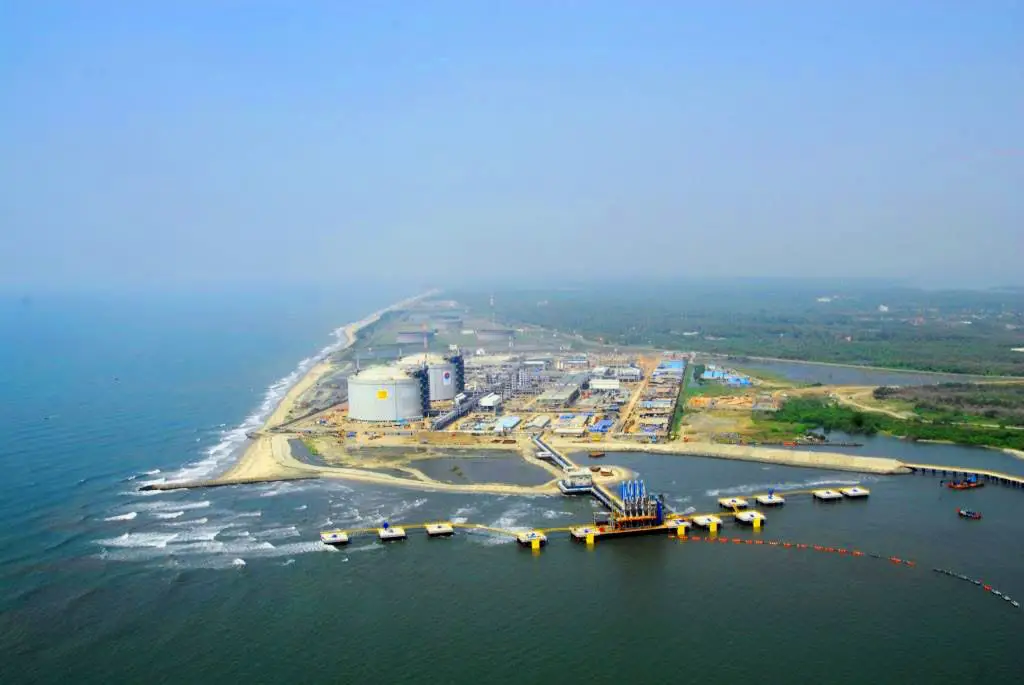
Embark on a ferry ride to Vypin Island and explore its pristine beaches, lighthouses, and vibrant local markets.Nestled along the Arabian Sea, Vypin Island emerges as a serene jewel in Kerala’s coastal tapestry. With its pristine beaches, lush landscapes, and vibrant local culture, Vypin beckons travelers seeking tranquility and natural beauty. Let’s embark on a journey to explore the allure of Vypin Island, where the rhythmic tides echo the harmonious blend of tradition and scenic wonders.
Golden Sands and Azure Waters:
Vypin Island welcomes visitors with stretches of golden sands caressed by the azure waters of the Arabian Sea. The pristine beaches, including Cherai Beach, offer a perfect retreat for those seeking sun-kissed shores and gentle waves.
Cherai Backwaters:
The backwaters surrounding Vypin Island add an enchanting dimension to its coastal charm. A boat ride along the Cherai backwaters provides a peaceful escape, offering glimpses of traditional fishing practices and serene landscapes.
Cherai Gowreeshwara Temple:
Immerse yourself in the spiritual ambiance of Cherai Gowreeshwara Temple, situated on the northern tip of Vypin Island. The temple’s architecture, dedicated to the goddess Gowreeshwara, reflects the vibrant religious traditions of Kerala.
Vypin Lighthouse:
For panoramic views of the surrounding landscapes, venture to the Vypin Lighthouse. The climb to the top is rewarded with breathtaking vistas of the Arabian Sea, lush greenery, and the charming villages that dot the island.
Fort Kochi-Vypin Ferry:
Enhance your island experience by taking the ferry from Vypin to Fort Kochi. The short ride offers a picturesque journey across the backwaters, providing a unique perspective of the coastal beauty that defines this region.
St. Mary’s Forane Church:
Explore the spiritual heritage of Vypin at St. Mary’s Forane Church in Pallipuram, one of the oldest European-built churches in India. The church’s architecture and historical significance make it a must-visit for history enthusiasts.
Kuzhuppilly Beach:
Discover the tranquility of Kuzhuppilly Beach, a hidden gem on Vypin Island. This less-explored beach offers solitude and natural beauty, making it an ideal spot for a quiet escape and introspective moments.
Vypin Fish Market:
Immerse yourself in the vibrant local culture by visiting the Vypin Fish Market. Experience the hustle and bustle as fishermen bring in their catch of the day, providing an authentic glimpse into the coastal livelihood that sustains the island.
Vypin Island, with its unspoiled beaches, cultural treasures, and coastal vistas, is a testament to the natural and cultural richness that defines Kerala. Whether you seek moments of tranquility, cultural exploration, or simply wish to embrace the beauty of the Arabian Sea, Vypin Island invites you to discover the timeless allure that makes it a true gem on Kerala’s coastal canvas.
St. Francis Church:
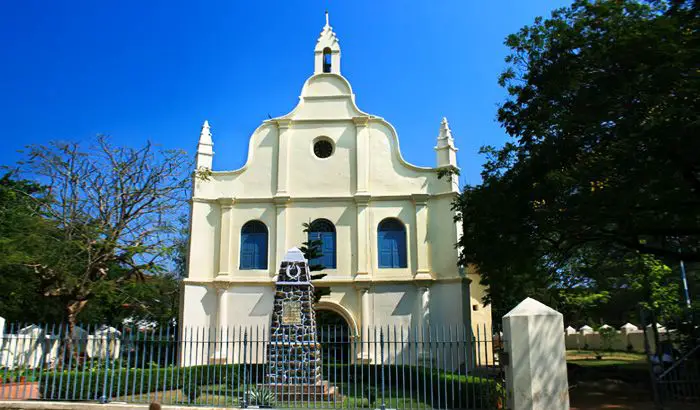
Just a stone’s throw away from Fort Kochi Beach, St. Francis Church stands as one of the oldest European churches in India. Built by the Portuguese in 1503, it holds historical significance as the final resting place of Vasco da Gama.Nestled in the heart of Fort Kochi, St. Francis Church stands as a silent witness to the ebb and flow of centuries, bearing the imprints of Kerala’s colonial past. This iconic structure, with its weathered walls and ancient aura, has transcended time to become a living chronicle of the region’s history. Let’s embark on a journey through the hallowed halls of St. Francis Church and unravel the tales etched into its stone walls.
Colonial Footprints:
St. Francis Church, believed to be one of the oldest European-built churches in India, traces its origins back to the early 16th century. Constructed by the Portuguese Franciscan friars in 1503, the church symbolizes the advent of European colonial powers in the Malabar region.
Architecture of Antiquity:
The architectural style of St. Francis Church is a fascinating blend of Gothic and Portuguese influences. Its stark whitewashed exterior and simple yet elegant design reflect the austerity and purpose for which it was originally built.
Vasco da Gama’s Final Resting Place:
The church holds a poignant historical connection as the final resting place of the legendary Portuguese explorer Vasco da Gama. Although his mortal remains were later relocated to Lisbon, the tombstone stands as a testament to the intertwining of global history and local heritage.
Dutch Occupation and Renovations:
Over the years, St. Francis Church underwent transformations under Dutch rule in the 17th century. The interior renovations reflect Dutch Protestant aesthetics, evident in the pulpit and furniture that remain to this day.
British Influence:
With the British occupation of Fort Kochi, St. Francis Church underwent further modifications. The church became an Anglican church during this period, with the British East India Company leaving its imprint on the architectural elements.
Historic Significance:
St. Francis Church has witnessed the pages of history unfold, from the spice trade era to colonial rivalries and the cultural amalgamation that defines modern-day Kochi. It remains a symbol of endurance, standing tall as a testament to the resilience of Kochi’s cultural and religious fabric.
The Whispering Walls:
As you step into the hallowed halls of St. Francis Church, the stone walls seem to whisper tales of bygone eras. The aged wooden beams, intricately carved pulpit, and ancient artifacts evoke a sense of reverence and nostalgia, transporting visitors to a different epoch.
Religious Harmony:
St. Francis Church transcends religious divides, symbolizing the harmonious coexistence of various faiths in Kochi. It serves as a living testament to the cultural diversity and tolerance that have characterized the region throughout its storied history.
St. Francis Church, with its weathered facade and centuries-old echoes, is more than a religious edifice; it is a living testament to the confluence of cultures, faiths, and histories that have shaped Kochi. As you walk through its doors, you step into the footprints of explorers, colonial powers, and the resilient spirit of a city that continues to honor and preserve its rich heritage.
Fort Kochi Walkway:

Embark on a leisurely stroll along the Fort Kochi Walkway that runs parallel to the beach. Lined with vibrant art installations, quaint shops, and cozy cafes, this promenade provides a delightful experience amid the sea breeze.Fort Kochi, with its rich tapestry of history and vibrant cultural heritage, unfolds its charm along the serene Fort Kochi Walkway. This picturesque promenade invites locals and visitors alike to embark on a leisurely stroll along the Arabian Sea, where the salty breeze carries whispers of a bygone era. Let’s explore the Fort Kochi Walkway, where every step is a journey through the cultural, historical, and artistic wonders that define this coastal gem.
Scenic Arabian Sea Views:
The Fort Kochi Walkway offers breathtaking views of the Arabian Sea, providing a panoramic backdrop for a tranquil stroll. The rhythmic waves and the distant horizon create a serene atmosphere, making it an ideal spot for relaxation and introspection.
Chinese Fishing Nets:
Along the walkway, the iconic Chinese fishing nets stand as sentinels of Kochi’s maritime history. Watching fishermen maneuver these colossal nets, a technique believed to have been introduced by Chinese traders centuries ago, adds a unique and authentic touch to the coastal ambience.
Historical Monuments:
Fort Kochi boasts a rich history, and the walkway is adorned with historical monuments that narrate tales of colonial influences. St. Francis Church, Vasco da Gama’s tomb, and other landmarks serve as reminders of the city’s cultural amalgamation over the centuries.
Artistic Murals:
The walkway is adorned with vibrant street art and murals that reflect the artistic spirit of Kochi. These murals showcase a blend of contemporary expressions and traditional influences, creating an open-air gallery that adds a splash of color to the surroundings.
Waterfront Cafés and Shops:
The Fort Kochi Walkway is dotted with charming waterfront cafés and shops, offering a delightful blend of local flavors and handicrafts. Visitors can indulge in a cup of freshly brewed coffee or explore unique souvenirs, enhancing the overall cultural experience.
Kochi Biennale Installations:
Fort Kochi, known for hosting the Kochi-Muziris Biennale, often features art installations along the walkway during the biennale period. These temporary exhibits add an element of contemporary art to the historical setting, creating a dynamic interplay between tradition and modernity.
Paradesi Synagogue and Jew Town:
The walkway seamlessly connects to the historic Jew Town, where the Paradesi Synagogue stands as a testament to Kochi’s multicultural past. A short stroll from the walkway opens doors to the vibrant markets, antique shops, and the rich Jewish heritage of the region.
Sunset Spectacle:
As the day draws to a close, the Fort Kochi Walkway transforms into a magical setting for witnessing the sunset. The changing hues of the sky, reflected in the waters, create a visual spectacle that captivates both locals and tourists alike.
The Fort Kochi Walkway transcends its role as a mere promenade; it is a cultural corridor, a historical thoroughfare, and an artistic canvas where the past and present harmoniously converge. Whether you’re a history enthusiast, an art lover, or someone seeking a peaceful waterfront escape, the Fort Kochi Walkway beckons, promising an enriching journey through the diverse layers of Kochi’s heritage.
Fort Kochi Bastion Bungalow:
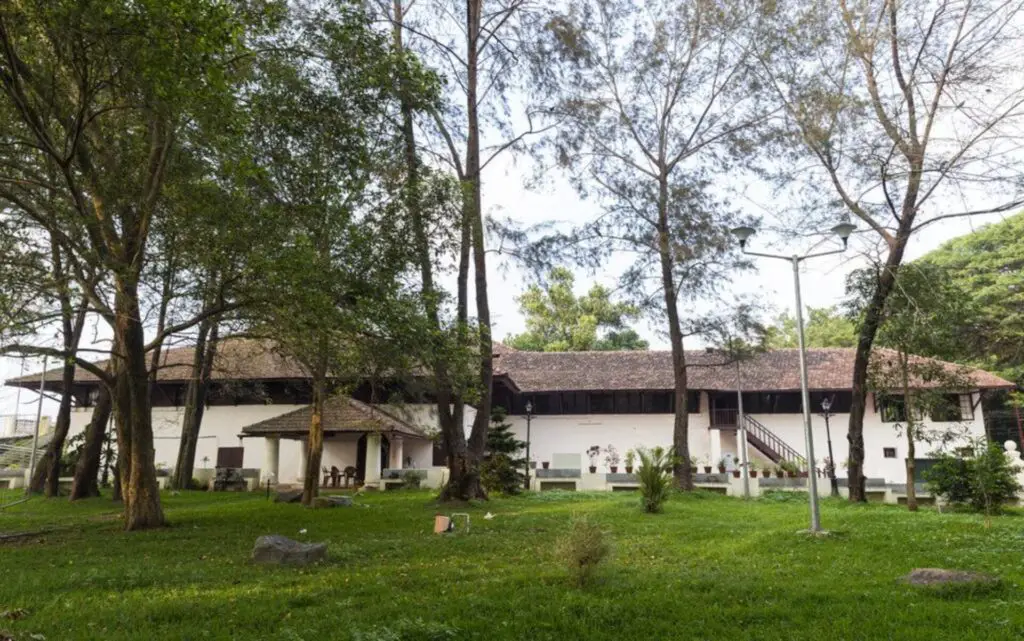
Nestled in the heart of Fort Kochi, the Bastion Bungalow stands as a living testament to the colonial legacy that defines the region. This stately structure, with its architectural grandeur and historical significance, has been meticulously preserved to offer guests a unique glimpse into Kochi’s past. Let’s embark on a journey to explore the charm and allure of Fort Kochi’s Bastion Bungalow, where every nook echoes with the whispers of a bygone era.
Colonial Relic:
The Bastion Bungalow, constructed in the early 17th century, stands as one of the oldest Dutch buildings in Fort Kochi. Its architectural style reflects a blend of Dutch and Portuguese influences, showcasing the rich tapestry of colonial history that has unfolded within its walls.
Strategic Location:
Positioned near the iconic St. Francis Church, the bungalow served a strategic purpose during colonial times. Originally built as a residence for the Dutch governor, its location near the church and within the Fort Kochi area highlights its role in the region’s colonial administration.
Architectural Splendor:
The architectural splendor of the Bastion Bungalow is evident in its sturdy structure, sloping roofs, and large windows that allow ample natural light. The building’s design exemplifies the practical yet aesthetically pleasing approach favored by Dutch colonial architects.
Restored Elegance:
Over the years, the Bastion Bungalow has undergone careful restoration to maintain its original elegance. The interiors boast antique furniture, period-specific decor, and an ambiance that transports guests back in time, offering a unique blend of historical charm and modern comfort.
Bastions and Gardens:
The bungalow derives its name from the bastions or fortified towers that once surrounded it. Today, the well-maintained gardens surrounding the bungalow add to its charm, providing a tranquil oasis in the midst of the bustling Fort Kochi area.
Cultural Hub:
Beyond being a heritage residence, the Bastion Bungalow has become a cultural hub in Fort Kochi. It often hosts art exhibitions, cultural events, and performances, fostering a connection between the historical past and contemporary expressions of art and creativity.
Heritage Hospitality:
The Bastion Bungalow has been adapted into a heritage hotel, allowing guests to experience the charm of colonial living. The hotel preserves the authenticity of the bungalow while offering modern amenities, creating a unique accommodation option for history enthusiasts and discerning travelers.
Proximity to Historical Landmarks:
Staying at the Bastion Bungalow provides guests with easy access to Fort Kochi’s myriad historical landmarks, including St. Francis Church, the Chinese Fishing Nets, and the Santa Cruz Basilica. The bungalow’s location allows visitors to immerse themselves in the rich historical and cultural tapestry of the area.
The Bastion Bungalow in Fort Kochi is more than just a heritage structure; it is a time capsule that encapsulates the essence of Kochi’s colonial past. Whether you choose to explore its historical corridors, stay within its restored rooms, or attend cultural events hosted within its premises, the Bastion Bungalow stands as an architectural gem that invites guests to step into the footsteps of history.
Princess Street:
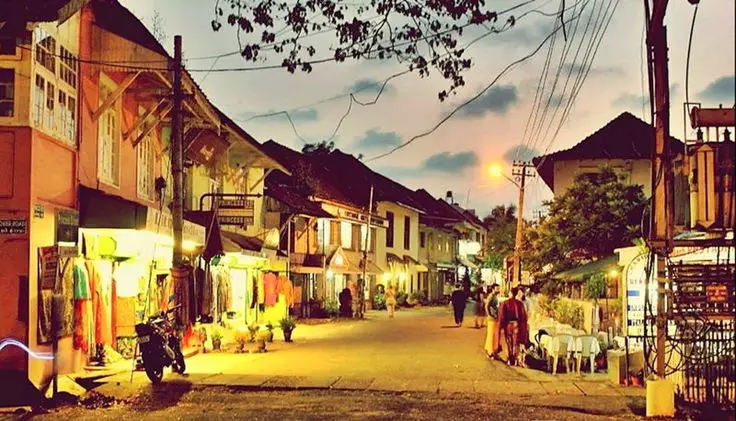
Immerse yourself in the old-world charm of Princess Street, a narrow cobbled lane lined with colonial-era buildings, boutique shops, and cafes. It’s a perfect place for a leisurely walk and exploration.Princess Street, nestled in the heart of Fort Kochi, is a charming thoroughfare that encapsulates the essence of Kochi’s colonial past. Lined with vibrant colonial-era buildings, quaint cafes, and boutique stores, Princess Street is a picturesque promenade that invites visitors to step back in time and savor the cultural tapestry of this historic city. Let’s embark on a journey through the cobblestone streets of Princess Street, where every step is a stroll through colonial elegance.
Colonial Heritage:
Princess Street stands as a living testament to Kochi’s colonial history. The architecture along this charming street reflects the influences of Portuguese, Dutch, and British colonial periods, creating a captivating blend of styles that adds to the area’s unique character.
Cobblestone Charm:
The cobblestone streets of Princess Street evoke a sense of nostalgia, transporting visitors to a bygone era. The gentle clatter of footsteps on these weathered stones sets the perfect ambiance for a leisurely exploration of the surroundings.
Colorful Storefronts:
The storefronts along Princess Street boast a burst of colors, adding vibrancy to the colonial architecture. Boutique stores showcase an array of curated collections, ranging from handmade crafts to antique artifacts, creating a delightful shopping experience for visitors.
Art Galleries and Studios:
Princess Street has become a hub for artistic expressions, with numerous art galleries and studios dotting its lanes. Visitors can explore contemporary and traditional art, showcasing the dynamic creative spirit that thrives within the historical context.
Quaint Cafés and Restaurants:
The street is adorned with quaint cafes and eateries that offer a culinary journey through local and international flavors. Outdoor seating allows patrons to soak in the laid-back atmosphere while relishing delicious meals against the backdrop of colonial architecture.
Boutique Accommodations:
Princess Street is home to boutique accommodations that seamlessly blend colonial charm with modern comfort. These heritage hotels provide a unique lodging experience, allowing guests to immerse themselves in the historical ambiance of Kochi.
St. Francis Church and Santa Cruz Basilica:
Princess Street leads to iconic landmarks such as St. Francis Church and Santa Cruz Basilica. The proximity to these historical sites allows visitors to seamlessly transition from the charming lanes of Princess Street to the awe-inspiring architecture of these colonial-era churches.
Cultural Events and Festivals:
The street comes alive during cultural events and festivals. The Princess Street Carnival, held annually, is a celebration of art, music, and local culture that attracts both residents and tourists, creating a festive atmosphere along the historic lanes.
Princess Street in Kochi is more than just a thoroughfare; it is a living canvas that paints a vivid picture of the city’s colonial past. As visitors meander through its cobblestone lanes, explore boutique stores, and indulge in culinary delights, they become part of the narrative that Princess Street weaves—a narrative of cultural richness, architectural elegance, and the timeless allure of Kochi’s historic charm.
Kashi Art Gallery, Kochi:
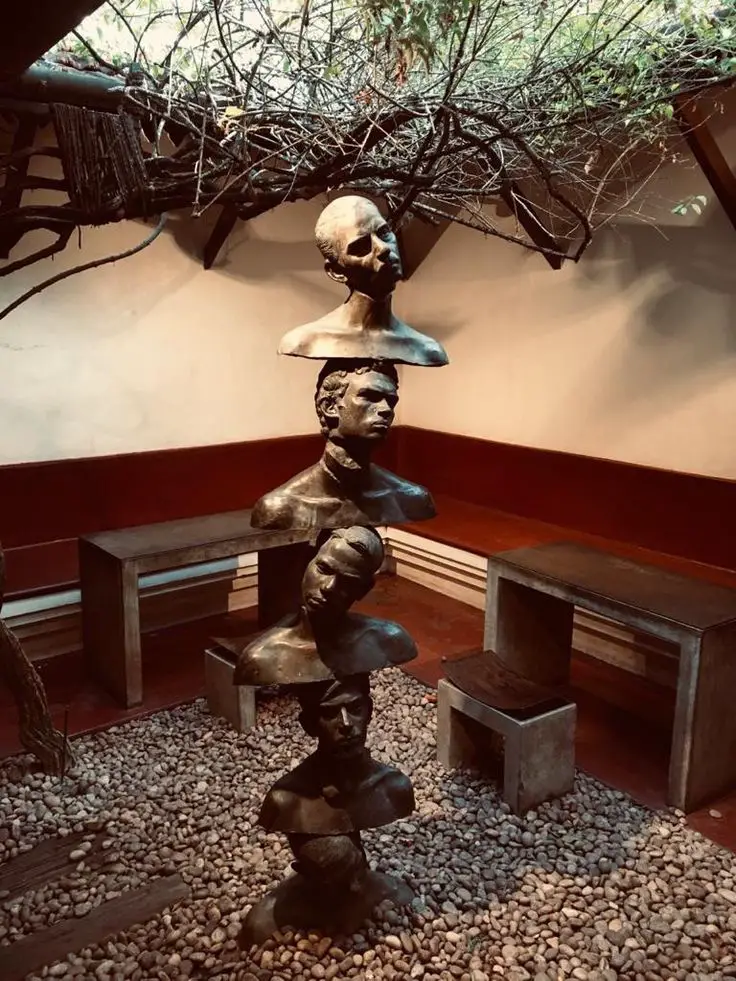
Nestled within the vibrant cultural enclave of Fort Kochi, the Kashi Art Gallery stands as a beacon for artistic expression and creativity. This contemporary art space, with its eclectic mix of visual arts, sculptures, and installations, has become a pivotal hub for both local and international artists. Let’s delve into the world of Kashi Art Gallery, where every stroke, sculpture, and exhibit contributes to the kaleidoscopic canvas of Kochi’s burgeoning art scene.
A Creative Haven:
Kashi Art Gallery, situated on Burgher Street in Fort Kochi, is a creative haven that beckons art enthusiasts and curious minds alike. The gallery’s unassuming facade opens up to a world of imagination, where each exhibit is a testament to the boundless realms of artistic expression.
Contemporary Art Showcase:
The gallery curates an impressive array of contemporary art, featuring works that span various mediums and styles. From paintings and sculptures to multimedia installations, Kashi Art Gallery embraces the diverse and dynamic landscape of modern artistic endeavors.
Charming Ambiance:
Set within a charming heritage building, the ambiance of Kashi Art Gallery is as captivating as the art it houses. The juxtaposition of traditional architecture with the avant-garde spirit of the exhibits creates an atmosphere that invites introspection and appreciation.
Curation and Collaboration:
Kashi Art Gallery prides itself on its thoughtful curation, often featuring emerging talents alongside established artists. This commitment to showcasing a spectrum of artistic voices contributes to the gallery’s reputation as a dynamic platform for creative discourse.
Artistic Events and Workshops:
Beyond static exhibits, the gallery hosts a myriad of artistic events, workshops, and interactive sessions. These events serve as a bridge between artists and the community, fostering a cultural exchange that enriches both creators and appreciators of art.
Café Art Beat:
Complementing the gallery is Café Art Beat, an in-house culinary counterpart that adds a delightful gastronomic dimension to the art experience. Visitors can savor gourmet delights amidst an ambiance that mirrors the gallery’s artistic ethos.
Local and Global Perspectives:
Kashi Art Gallery actively promotes both local and global perspectives in the art world. By featuring artists with diverse cultural backgrounds and influences, the gallery contributes to a global dialogue while grounding itself in the rich cultural tapestry of Kerala.
Community Engagement:
The gallery’s commitment to community engagement is evident through outreach programs, educational initiatives, and collaborative projects. Kashi Art Gallery seeks to democratize art, making it accessible and meaningful to a broad audience.
Kashi Art Gallery emerges as more than just a space to showcase art; it is a dynamic crucible where creativity converges, collaborations flourish, and cultural narratives unfold. As it continues to be a nurturing ground for artistic exploration and expression, Kashi Art Gallery stands as a testament to Kochi’s evolving identity as a vibrant cultural hub in God’s Own Country.
Conclusion:
In the heart of Kerala, Kochi unveils a captivating tapestry of culture, history, and natural beauty that leaves an indelible mark on every visitor. As we conclude our exploration of the 20+ best places to visit in Kochi in 2024, it becomes evident that this city is more than just a destination—it’s an immersive experience.
From the iconic Chinese Fishing Nets that silhouette the horizon to the historic St. Francis Church echoing tales of exploration, Kochi invites travelers to embark on a journey through time. The vibrant hues of the Kochi-Muziris Biennale, the serene backwaters crisscrossing the landscape, and the lush greenery of Mangalavanam Bird Sanctuary paint a vivid picture of the city’s diverse offerings.
Fort Kochi’s walkways, bastions, and bungalows stand as silent witnesses to the footsteps of explorers, traders, and colonial powers. The lively Princess Street with its cobblestone charm reflects a harmonious blend of tradition and modernity, while Kashi Art Gallery adds a contemporary touch to the city’s cultural canvas.
As you traverse through the historic lanes, pristine beaches, and cultural enclaves, Kochi unfolds as a city that seamlessly integrates its past with the present. Whether you are a history enthusiast, an art lover, a nature seeker, or someone in search of culinary delights, Kochi beckons with open arms, promising an enriching sojourn that goes beyond the ordinary.
In 2024, as you set foot on the enchanting shores of Kochi, may you discover not just places but stories, not just sights but experiences, and above all, the enduring charm that makes Kochi a timeless destination on India’s southwestern coast. Embrace the magic of Kochi, where every corner holds a piece of history, every breeze carries whispers of tales untold, and every visit leaves an imprint on the canvas of your memories.
FAQs
1: What makes Kochi a must-visit destination in 2024?
Kochi boasts a rich blend of history, culture, and natural beauty. In 2024, the city offers a vibrant tapestry of experiences, from historic sites to cultural events, making it a compelling destination.
2: What are the iconic landmarks to explore in Kochi?
Explore iconic landmarks such as the Chinese Fishing Nets, St. Francis Church, Fort Kochi walkways, and the historic Mattancherry Palace, each offering a unique glimpse into Kochi’s rich heritage.
3: Are there opportunities for art enthusiasts in Kochi?
Absolutely! Kochi hosts the renowned Kochi-Muziris Biennale, showcasing contemporary art. Visit Kashi Art Gallery for a mix of modern and traditional artistic expressions.
4: How can I experience Kochi’s natural beauty?
Immerse yourself in the serene backwaters with a boat ride, visit lush bird sanctuaries like Mangalavanam, and relax on the golden sands of Cherai Beach for a nature-filled experience.
5: Are there options for heritage stays in Kochi?
Yes, Kochi offers heritage stays like the Bastion Bungalow and Bolgatty Palace, allowing guests to relish the charm of colonial-era architecture with modern comforts.
6: What are some offbeat places to explore in Kochi?
Discover Princess Street for its colonial charm, Vypin Island for its pristine beaches, and the quiet lanes of Jew Town for a unique and offbeat experience.
7: How can I explore Kochi’s art scene beyond the Biennale?
Visit Kashi Art Gallery for contemporary art, explore street art along Fort Kochi walkways, and attend cultural events that often take place in the city’s vibrant locales.
8: Are there family-friendly attractions in Kochi?
Yes, Kochi has family-friendly attractions like the Hill Palace Museum, Cherai Beach, and Dutch Cemetery, providing a mix of history, nature, and relaxation.
9: What is the best time to visit Kochi in 2024?
The winter months from October to February offer pleasant weather, making it the best time to visit Kochi. This period ensures comfortable exploration of the city’s attractions.
10: How can I make the most of my visit to Kochi?
To make the most of your visit, plan a diverse itinerary that includes historical landmarks, cultural experiences, natural retreats, and culinary delights, ensuring a holistic exploration of Kochi’s charm in 2024.


